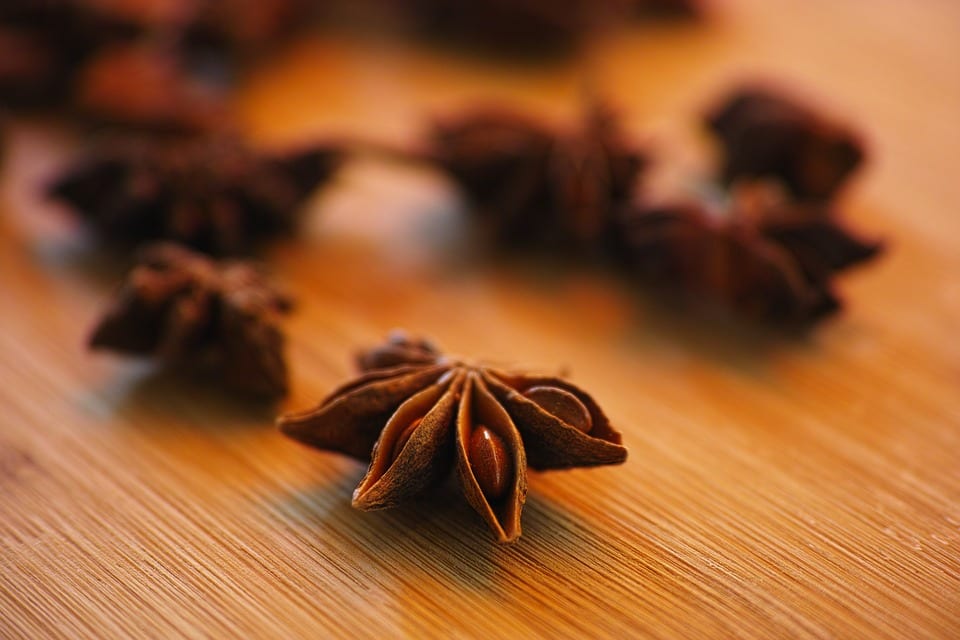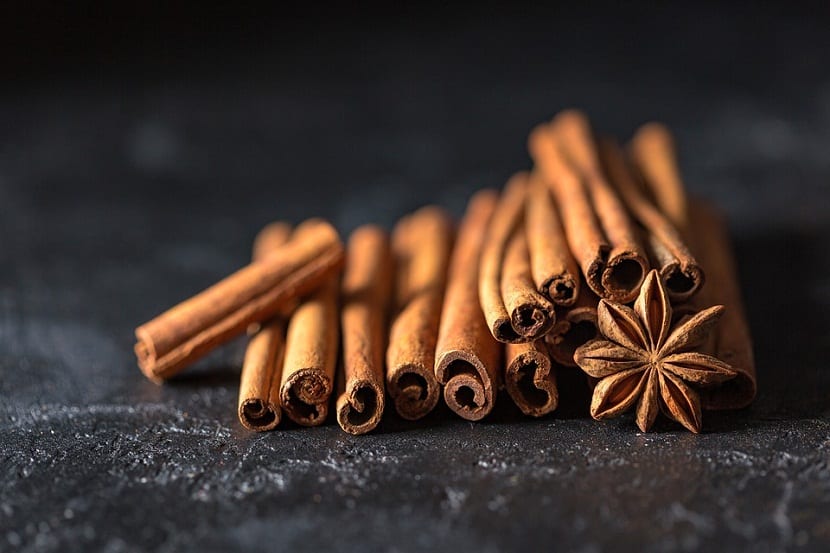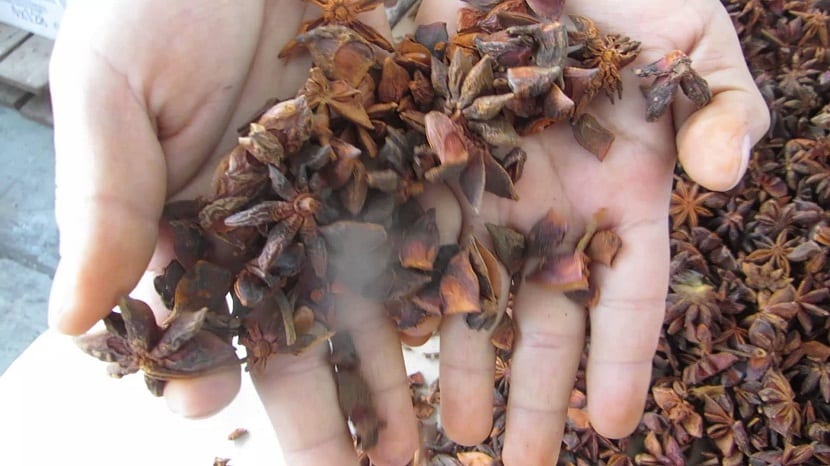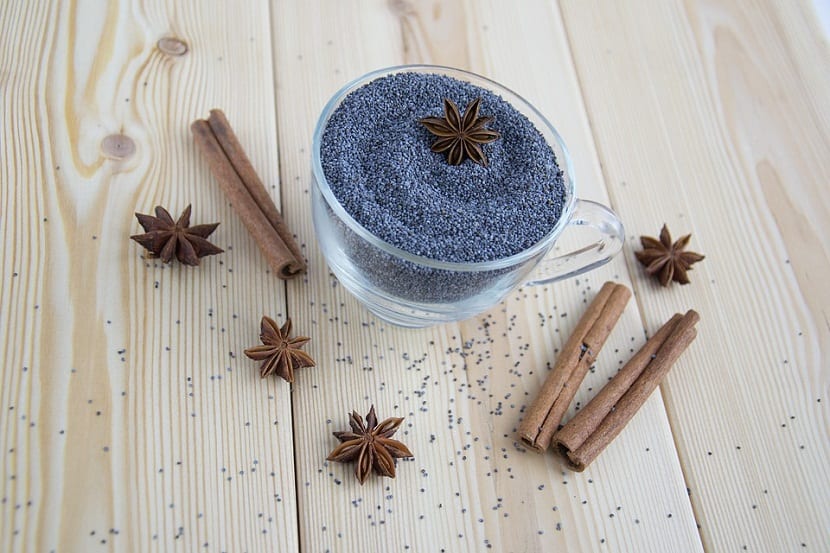
Anise belongs botanically to the family apiaceae and is scientifically known as the Pimpinella anisum. This anise plant comes from the Middle East and the entire Mediterranean region, but probably originated in the plains of the Nile delta, in lower Egypt.
Anise seeds have elongated or curved shape, about 3-4 mm long, light brown in color and with fine stripes on the outer surface. The seeds have a very sweet and aromatic aroma with a very unique flavor.
Characteristics of anise seeds

Anise seed is obtained from an evergreen tree Native to southwestern China and inland, these fruits feature rounded, amber seeds. Both the seed as well as the husks is used as a spice in cooking.
Properties of anise seeds
The exotic spice of anise is among the most important plants, thanks to its chemical compounds that are known to have antioxidant properties, for disease prevention and properties to strengthen health in general.
The volatile essential oil that gives that sweet, aromatic flavor characteristic to the anise seed is the anethole. Other important compounds found in these beans include estragole, p-anisaldehyde, anise alcohol, acetophenone, pinene, and limonene.
The anise seed oil obtained from the extraction of the seeds has many applications in so-called traditional medicine as a stomachic, antiseptic, anti-spasmodic, digestive, expectorant, stimulant, and tonic agent.
The seeds are an excellent source of many B vitamins essentials such as pyridoxine, niacin, riboflavin, and thiamine. Pyridoxine helps increase neurochemical levels of GABA in the brain.
Also these seeds are one of the important sources of minerals such as calcium, iron, copper, potassium, manganese, zinc and magnesium and is that 100 g of dried seeds contains about 36,96 mg or 462% of the required daily levels of iron. Potassium is an important component of cellular and body fluids that helps control heart rate and blood pressure.
Copper is another cofactor for many vital enzymes, including cytochrome C-oxidase and superoxide dismutase. Other minerals that function as cofactors for this enzyme are manganese and zinc. Copper is also necessary for the production of red blood cells.
The spice too contains good amounts of antioxidant vitamins like vitamin C and vitamin A.
Your selection and storage

Anise powder is readily available in the spice market all year round, so we recommend choosing anise seeds from organic herb stores for its guarantee of purity and authenticity.
Buy in small portions to last 3-4 months as they lose their flavor due to evaporation of essential oils. Fresh seeds should be olive green to glossy gray-brown in color and with a rich aroma when rubbed between the thumb and index finger.
Avoid seeds that have broken tips since they do not have essential oils and therefore are of inferior quality.
In your house, store the anise in several airtight containers and trying that the place is cool and does not hit the sunlight. Ground anise powder should be kept in airtight containers and used as soon as possible as they lose their flavor very quickly.
Star anise, on the other hand, has a longer shelf life. Ground star anise should be stored in an airtight container, away from sunlight.
The medicinal use of anise seeds
Anise seeds, as well as their oil, have various applications in traditional medicine for promote unique health and the prevention of known diseases. Anise preparations are an excellent remedy for asthma, bronchitis, cough, as well as digestive disorders such as flatulence, bloating, stomach pain or colic, nausea and indigestion.
The essential oil that is anethole and comprises 75 - 90% of anise, has been shown to have an estrogenic effect. The seed decoction process It is often prescribed in nursing mothers to promote the production of breast milk and is that anise seed water is also very useful to alleviate certain conditions in the nose of babies.
These seeds and in some cultures, are chewed after food, as in India and Pakistan to freshen the breath in the mouth after eating, but we always recommend consulting with your doctor.
Anise and its culinary uses
Anise seeds, their oil, as well as young fresh leaves are widely used in cooking.
The flavor can be enhanced by gently roasting the seeds. You will notice that its seeds have a sweet and aromatic taste and they are used in a variety of tasty and sweet dishes.
Whole seeds or freshly ground powdered seeds can be added to recipes late in the making to limit evaporation of volatile essential oils.
This delicate spice used as a flavor base For soups, sauces, bread, cakes, cookies and in confectionery, anise seeds, as well as their oil, have been present for use in the preparation of sweet dishes in many Asian countries. Its seeds are also used as a flavor base for the preparation of herbal tea and a liqueur called anisette.
Star anise is one of the most important spices in Chinese cuisine and in fact, it is the dominant flavor in many dishes, along with cloves, cinnamon, Hua jiao (Sichuan pepper) and the fennel seed plant.
Services

Anise can be an immune booster to fight infection.
Animal research published in Pakistan has suggested that anise extract in broiler chicks has increased growth performance and immunity.
Anise can help you urinate more.
People may believe that it is a bad thing to urinate often. However, urinate helps your body get rid of many toxins and waste products. Anise oil has an anti-diuretic effect through a similar mechanism in your kidney.
Anise increases the absorption of glucose.
Anise oil improves glucose or sugar absorption. Those with type 2 diabetes have trouble absorbing sugar, but anise can help level their blood sugar levels.
Anise can help prevent airway obstruction.
An herbal compound containing garlic, white horehound, anise, fennel, licorice, thyme, and hyssop reduces clinical signs of recurrent airway obstruction.
Anise can help women and their reproductive health.
Anise has the potential to regulate the menstrual cycle in women. Anise helps relieve menstrual cramps and facilitates the birth of the baby.
As you will see, the uses and benefits of these seeds They are quite wide, so this spice cannot be missing in your kitchen.

If we are talking about anise seeds, why do they put star anise in the photos?